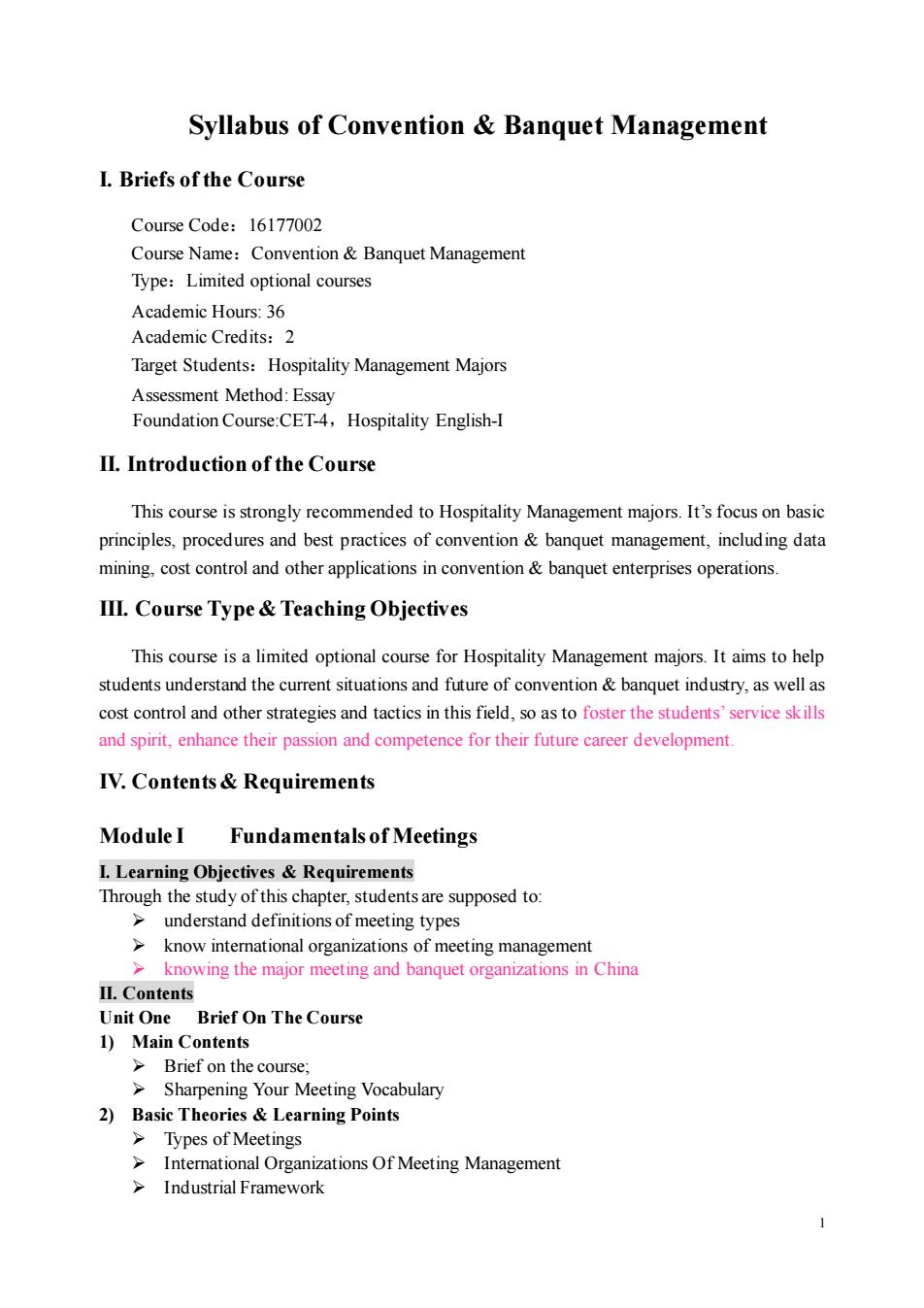
Syllabus of Convention Banquet Management I.Briefs of the Course Course Code:16177002 Course Name:Convention Banquet Management Type:Limited optional courses Academic Hours:36 Academic Credits:2 Target Students:Hospitality Management Majors Assessment Method:Essay Foundation Course:CET-4,Hospitality English-I II.Introduction of the Course This course is strongly recommended to Hospitality Management majors.It's focus on basic principles.procedures and best practices of convention&banquet management,including data mining,cost control and other applications in convention&banquet enterprises operations. III.Course Type Teaching Objectives This course is a limited optional course for Hospitality Management majors.It aims to help students understand the current situations and future of convention&banquet industry,as well as cost control and other strategies and tactics in this field.so as to foster the students'service skills and spirit,enhance their passion and competence for their future career development IV.Contents Requirements Module I Fundamentals of Meetings L.Learning Objectives &Requirements Through the study of this chapter,students are supposed to: >understand definitions of meeting types know international organizations of meeting management knowing the major meeting and banquet organizations in China II.Contents Unit One Brief On The Course 1)Main Contents >Brief on the course: Sharpening Your Meeting Vocabulary 2)Basic Theories Learning Points Types of Meetings International Organizations Of Meeting Management >Industrial Framework
1 Syllabus of Convention & Banquet Management I. Briefs of the Course Course Code:16177002 Course Name:Convention & Banquet Management Type:Limited optional courses Academic Hours: 36 Academic Credits:2 Target Students:Hospitality Management Majors Assessment Method: Essay Foundation Course:CET-4,Hospitality English-I II. Introduction of the Course This course is strongly recommended to Hospitality Management majors. It’s focus on basic principles, procedures and best practices of convention & banquet management, including data mining, cost control and other applications in convention & banquet enterprises operations. III. Course Type & Teaching Objectives This course is a limited optional course for Hospitality Management majors. It aims to help students understand the current situations and future of convention & banquet industry, as well as cost control and other strategies and tactics in this field, so as to foster the students’service skills and spirit, enhance their passion and competence for their future career development. IV. Contents & Requirements Module I Fundamentals of Meetings I. Learning Objectives & Requirements Through the study of this chapter, students are supposed to: ➢ understand definitions of meeting types ➢ know international organizations of meeting management ➢ knowing the major meeting and banquet organizations in China II. Contents Unit One Brief On The Course 1) Main Contents ➢ Brief on the course; ➢ Sharpening Your Meeting Vocabulary 2) Basic Theories & Learning Points ➢ Types of Meetings ➢ International Organizations Of Meeting Management ➢ Industrial Framework
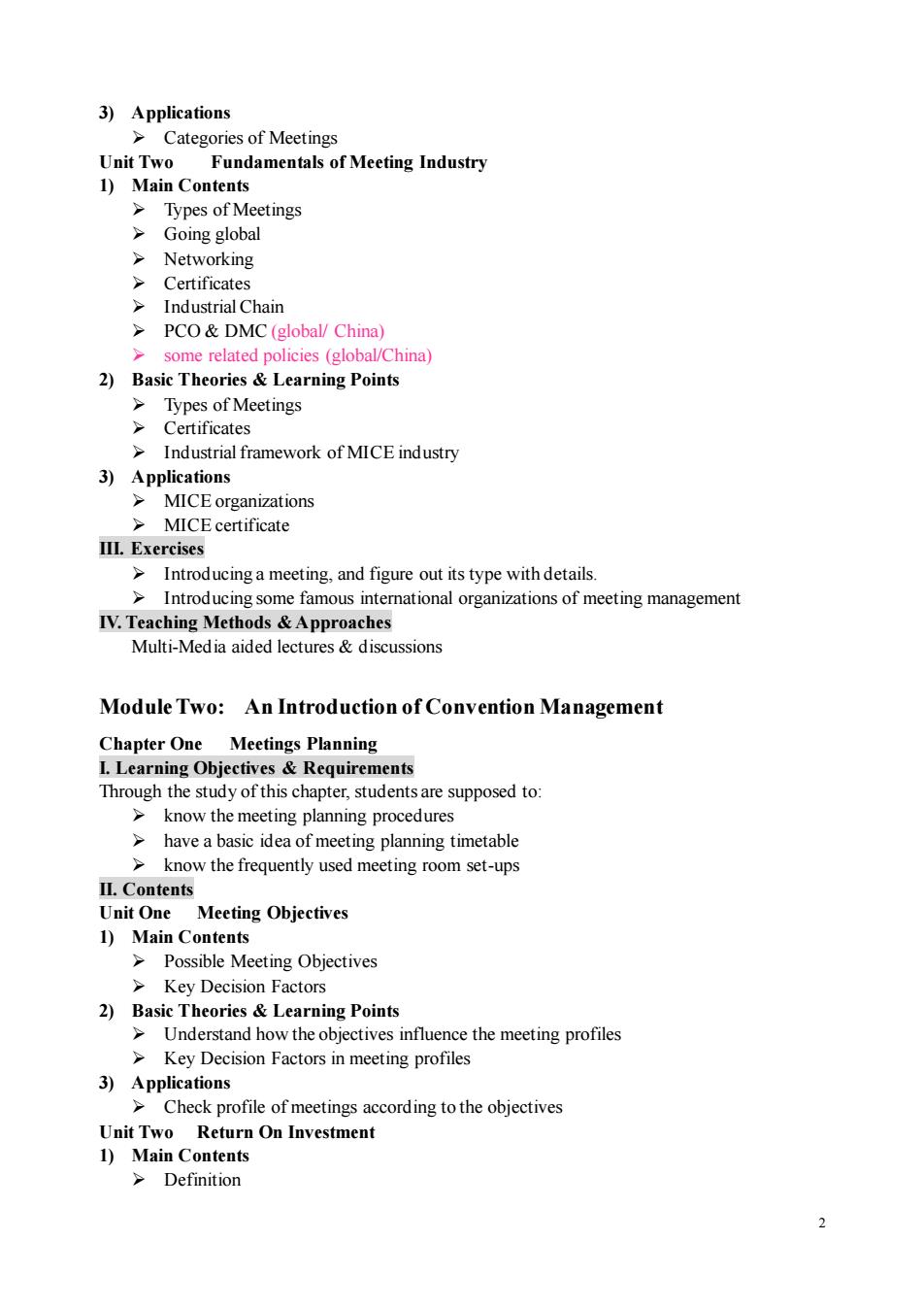
3)Applications Unit Two 1)Main Contents >Types of Meetings >Going global Certifica Industrial Chair >PCO&DMC (global/China) >some related policies (global/China) 2)Basic Theories Learning Points Types of Meetings >Industrial framework of MICE industry 3)Applications MICE organizations Introducing a meeting.and figure out its type with details. >Introducing some famous international organizations of meeting management IV.Teaching Methods &Approaches Multi-Media aided lectures&discussions Module Two:An Introduction of Convention Management Chapter One Meetings Planning I.Learning Objectives Requirements Through the study of this chapter,students are supposed to: know the meeting planning procedures have a basic idea of meeting planning timetable >know the frequently used meeting room set-ups II.Contents Unit One Meeting Objectives 1)Main Cont >Key Decision Factors 2)Basic Theories Learning Points Understand how the objectives influence the meeting profiles Key Decision Factors in meeting profiles 3)Applications >Check profile of meetings according to the objectives Unit Two Return On Investment 1)Main Contents >Definition
2 3) Applications ➢ Categories of Meetings Unit Two Fundamentals of Meeting Industry 1) Main Contents ➢ Types of Meetings ➢ Going global ➢ Networking ➢ Certificates ➢ Industrial Chain ➢ PCO & DMC (global/ China) ➢ some related policies (global/China) 2) Basic Theories & Learning Points ➢ Types of Meetings ➢ Certificates ➢ Industrial framework of MICE industry 3) Applications ➢ MICE organizations ➢ MICE certificate III. Exercises ➢ Introducing a meeting, and figure out its type with details. ➢ Introducing some famous international organizations of meeting management IV. Teaching Methods & Approaches Multi-Media aided lectures & discussions Module Two: An Introduction of Convention Management Chapter One Meetings Planning I. Learning Objectives & Requirements Through the study of this chapter, students are supposed to: ➢ know the meeting planning procedures ➢ have a basic idea of meeting planning timetable ➢ know the frequently used meeting room set-ups II. Contents Unit One Meeting Objectives 1) Main Contents ➢ Possible Meeting Objectives ➢ Key Decision Factors 2) Basic Theories & Learning Points ➢ Understand how the objectives influence the meeting profiles ➢ Key Decision Factors in meeting profiles 3) Applications ➢ Check profile of meetings according to the objectives Unit Two Return On Investment 1) Main Contents ➢ Definition
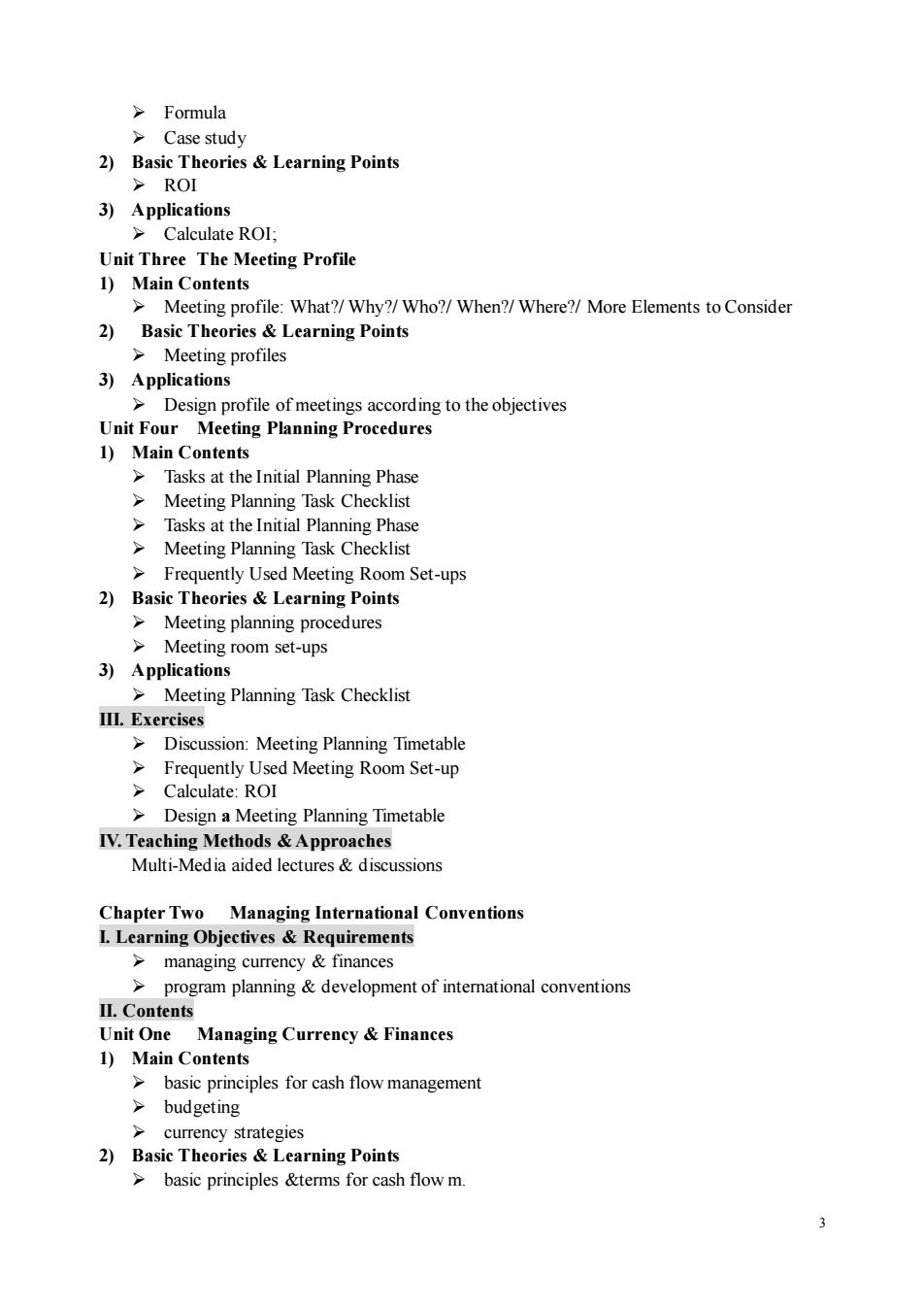
>Formula Case studv 2)Basic Theories Learning Points 3)Applications >Calculate ROl Unit Three The Meeting Profile D Main Contents A Mee ing profile:What?/Why?/Who?/When?/Where?/More Elements to Conside 2)Basic Theories Learning Points >Meeting profiles 3)Applications ng Planning Procedures 1)Main Contents P Tasks at the Initial Planning Phase >Meeting Planning Task Checklist >Tasks at the initial planning Phase >Meeting Planning Task Checklist Frequently Used Meeting Room Set-ups 2)Basic Theories Learning Points Meeting planning procedures >Meeting room set-ups 3)Applications Meeting Planning Task Checklist Ⅲ.Exercises Discussion:Meeting Planning Timetable >Frequently Used Meeting Room Set-up >Calculate:ROI Design a Meeting Planning Timetable IV.Teaching Methods &Approaches Multi-Med ia aided lectures discussions Chapter Two Managing International Conventions I.Learning Objectives Requirements managing currency finances >program planning development of international conventions II.Contents Unit One Managing Currency Finances 1)Main Contents basic principles for cash flow management budgeting >currency strategies 2)Basic Theories Learning Points >basic principles &terms for cash flow m
3 ➢ Formula ➢ Case study 2) Basic Theories & Learning Points ➢ ROI 3) Applications ➢ Calculate ROI; Unit Three The Meeting Profile 1) Main Contents ➢ Meeting profile: What?/ Why?/ Who?/ When?/ Where?/ More Elements to Consider 2) Basic Theories & Learning Points ➢ Meeting profiles 3) Applications ➢ Design profile of meetings according to the objectives Unit Four Meeting Planning Procedures 1) Main Contents ➢ Tasks at the Initial Planning Phase ➢ Meeting Planning Task Checklist ➢ Tasks at the Initial Planning Phase ➢ Meeting Planning Task Checklist ➢ Frequently Used Meeting Room Set-ups 2) Basic Theories & Learning Points ➢ Meeting planning procedures ➢ Meeting room set-ups 3) Applications ➢ Meeting Planning Task Checklist III. Exercises ➢ Discussion: Meeting Planning Timetable ➢ Frequently Used Meeting Room Set-up ➢ Calculate: ROI ➢ Design a Meeting Planning Timetable IV. Teaching Methods & Approaches Multi-Media aided lectures & discussions Chapter Two Managing International Conventions I. Learning Objectives & Requirements ➢ managing currency & finances ➢ program planning & development of international conventions II. Contents Unit One Managing Currency & Finances 1) Main Contents ➢ basic principles for cash flow management ➢ budgeting ➢ currency strategies 2) Basic Theories & Learning Points ➢ basic principles &terms for cash flow m
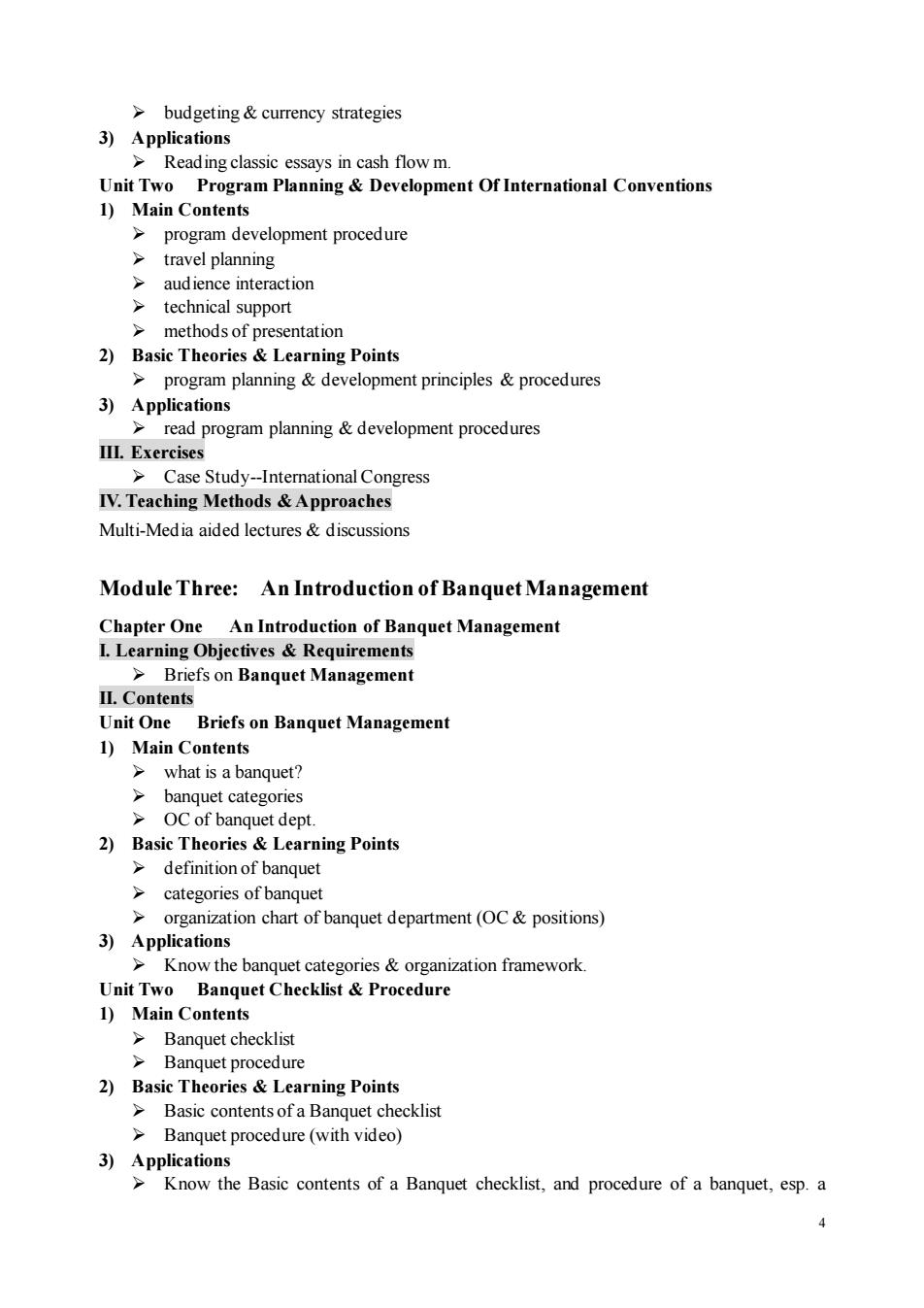
budgeting currency strategies ding classic essays in cash flow m. Unit Two Program Planning Development Of International Conventions 1)Main Contents program development procedure travel planning d nce intera tior technical support >methods of presentation 2)Basic Theories Learning Points >program planning development principles procedures ations read program planning development procedures III.Exercises >Case Study--International Congress IV.Teaching Methods &Approaches Multi-Media aided lectures&discussions Module Three:An Introduction of Banquet Management Chapter One An Introduction of Banquet Management L Learning Objectives Requirements >Briefs on Banquet Management II.Contents Unit One Briefs on Banquet Management 1)Main Contents what is a banquet? banquet categories >OC of banquet dept 2)Basic Theories Learning Points >definition of banquet categories of ba anque organization chart of banquet department(OC&positions) 3)Applications >Know the banquet categories organization framework. Unit Two Banquet Checklist Procedure 1)Main Contents Banquet checklist Banquet procedure 2)Basic Theories Learning Points >Basic contents of a Banquet checklist >Banquet procedure(with video) 3)Applications >Know the Basic contents of a Banquet checklist,and procedure of a banquet,esp.a
4 ➢ budgeting & currency strategies 3) Applications ➢ Reading classic essays in cash flow m. Unit Two Program Planning & Development Of International Conventions 1) Main Contents ➢ program development procedure ➢ travel planning ➢ audience interaction ➢ technical support ➢ methods of presentation 2) Basic Theories & Learning Points ➢ program planning & development principles & procedures 3) Applications ➢ read program planning & development procedures III. Exercises ➢ Case Study--International Congress IV. Teaching Methods & Approaches Multi-Media aided lectures & discussions Module Three: An Introduction of Banquet Management Chapter One An Introduction of Banquet Management I. Learning Objectives & Requirements ➢ Briefs on Banquet Management II. Contents Unit One Briefs on Banquet Management 1) Main Contents ➢ what is a banquet? ➢ banquet categories ➢ OC of banquet dept. 2) Basic Theories & Learning Points ➢ definition of banquet ➢ categories of banquet ➢ organization chart of banquet department (OC & positions) 3) Applications ➢ Know the banquet categories & organization framework. Unit Two Banquet Checklist & Procedure 1) Main Contents ➢ Banquet checklist ➢ Banquet procedure 2) Basic Theories & Learning Points ➢ Basic contents of a Banquet checklist ➢ Banquet procedure (with video) 3) Applications ➢ Know the Basic contents of a Banquet checklist, and procedure of a banquet, esp. a
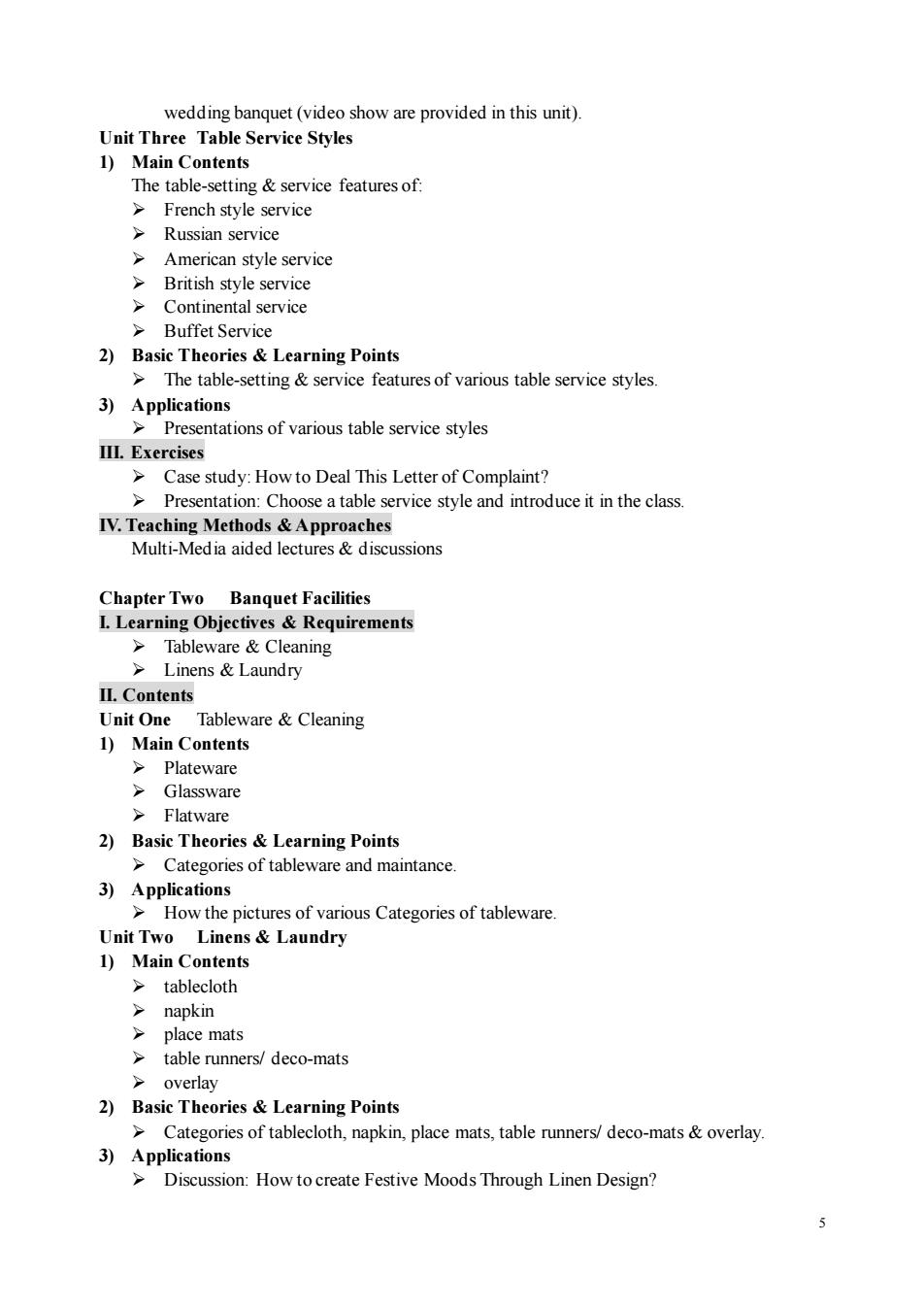
wedding banquet(video show are provided in this unit). Unit Three Table Service Stvles 1)Main Contents The table-setting&service featuresof French style service Russian service >American style service British style service ontine ntal service Buffet Service 2)Basic Theories Learning Points >The table-setting service features of various table service styles. 3)Applications Presentations of various table service styles III.Exercises >Case studv:How to Deal This Letter of Complaint? >Presentation:Choose a table service style and introduce it in the class. IV.Teaching Methods &Approaches Multi-Media aided lectures&discussions Chapter Two Banquet Facilities I.Learning Objectives Requirements >Tableware Cleaning >Linens Laundry II.Content Unit One Tableware Cleaning 1)Main Contents Plateware >Glassware Flatware 2)Basic Theories Learning Points >Categories of tableware and maintance. 3)Applications >How the pictures of various Categories of tableware Unit Two Linens Laundry 1)Main Cont >tablecloth napkin >place mats table runners/deco-mats overlay 2)Basic Theories Learning Points >Categories of tablecloth,napkin,place mats,table runners/deco-mats overlay. 3)Applications >Discussion:How to create Festive Moods Through Linen Design?
5 wedding banquet (video show are provided in this unit). Unit Three Table Service Styles 1) Main Contents The table-setting & service features of: ➢ French style service ➢ Russian service ➢ American style service ➢ British style service ➢ Continental service ➢ Buffet Service 2) Basic Theories & Learning Points ➢ The table-setting & service features of various table service styles. 3) Applications ➢ Presentations of various table service styles III. Exercises ➢ Case study: How to Deal This Letter of Complaint? ➢ Presentation: Choose a table service style and introduce it in the class. IV. Teaching Methods & Approaches Multi-Media aided lectures & discussions Chapter Two Banquet Facilities I. Learning Objectives & Requirements ➢ Tableware & Cleaning ➢ Linens & Laundry II. Contents Unit One Tableware & Cleaning 1) Main Contents ➢ Plateware ➢ Glassware ➢ Flatware 2) Basic Theories & Learning Points ➢ Categories of tableware and maintance. 3) Applications ➢ How the pictures of various Categories of tableware. Unit Two Linens & Laundry 1) Main Contents ➢ tablecloth ➢ napkin ➢ place mats ➢ table runners/ deco-mats ➢ overlay 2) Basic Theories & Learning Points ➢ Categories of tablecloth, napkin, place mats, table runners/ deco-mats & overlay. 3) Applications ➢ Discussion: How to create Festive Moods Through Linen Design?